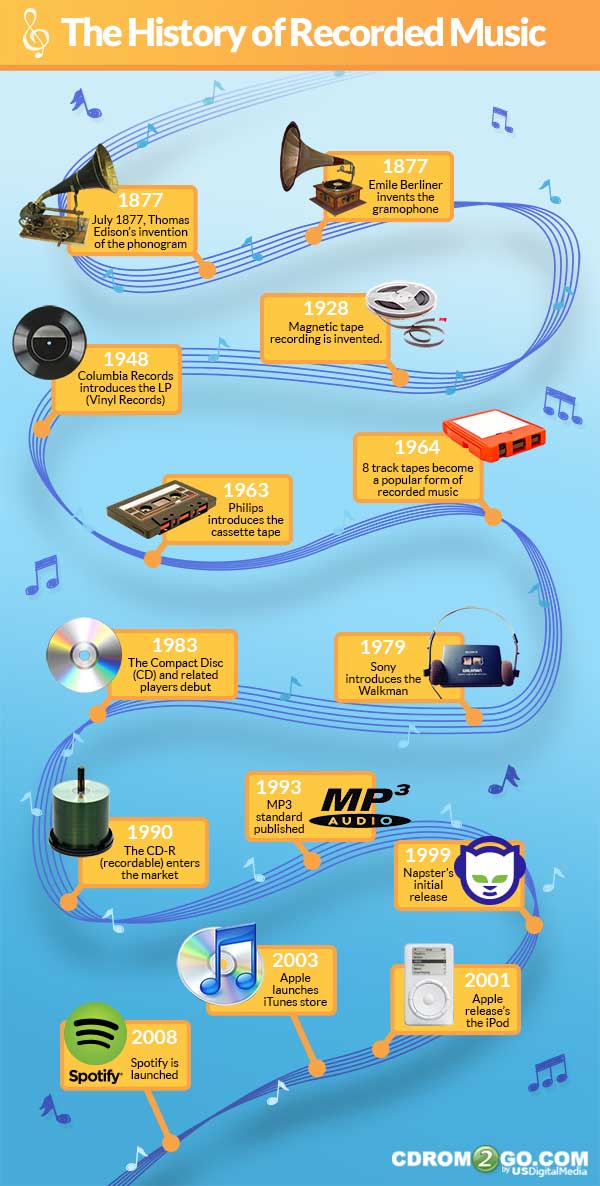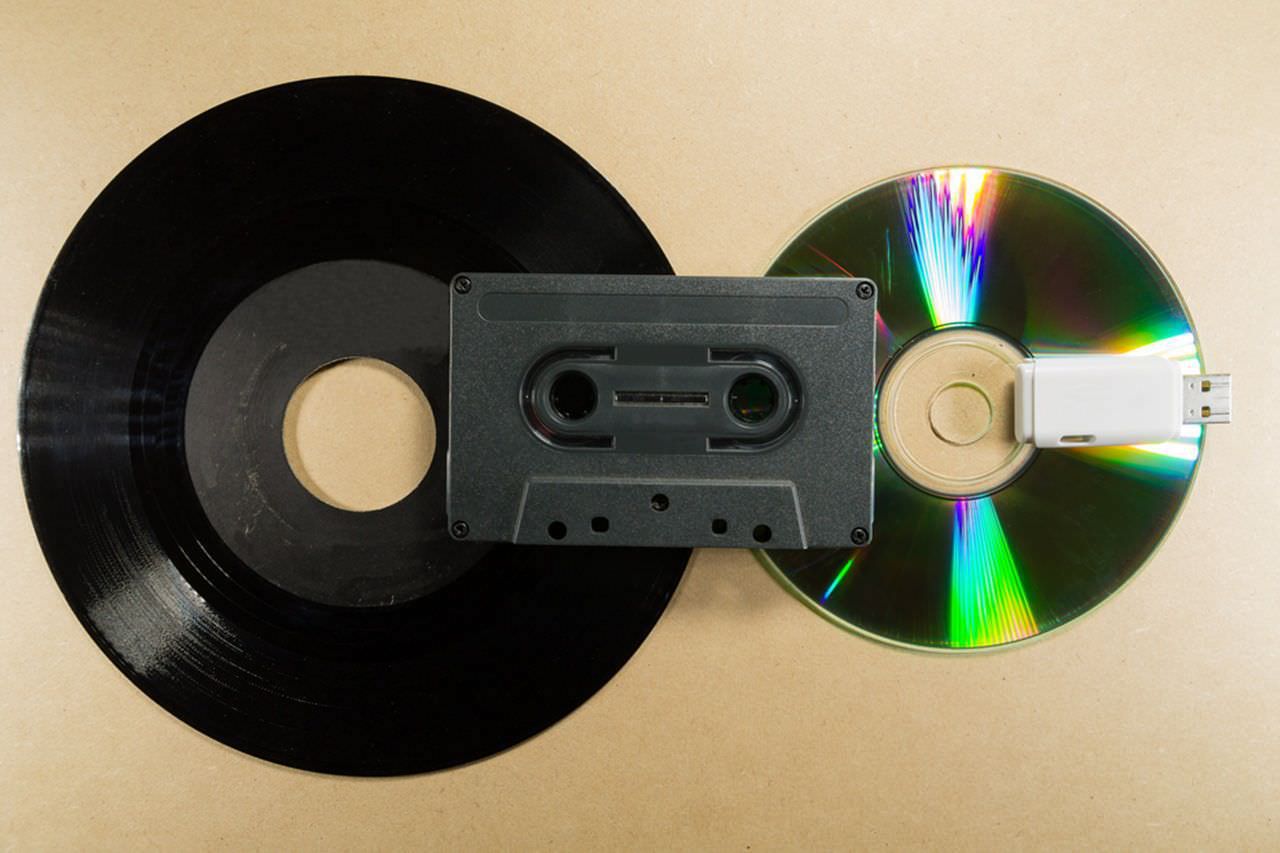
The Earliest Days
The age of music spans as long as humans have existed, at least. The history of recorded music, however, is much more recent. Before music was available in medium, the only way to consume it was to listen to it live. This changed in 1887 when Thomas Edison invented the phonograph. It consisted of a mechanical device using a grooved cylinder to produce music and a large horn to project it. It was capable of recording and playing audio, but early models were pretty pitiful performers. They improved with wax cylinders. Phonograph technology was incredibly limited and spotty; audio had to filter through the horn (microphones not being invented yet) which restricted the available recording space to immediately in front of it. Louder instruments became the norm in order to record properly but regardless, the sound quality wasn’t great. Later, the disc shaped medium was found to be an even better option with the competing gramophone (patented by Emile Berliner).
Discs were made of hard rubber, or occasionally celluloid, but shellac proved to be superior. The vinyl records that we are familiar with didn’t appear until after World War 2. These records could only contain up to 20 minutes of music per side.
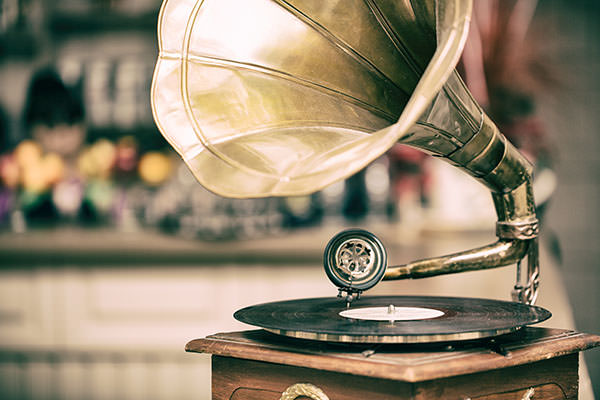
Radio
In the middle of all this invention was the emergence of radio. Invented by Gugliemo Marconi in 1895, radio became the de facto method of consuming live news, music, and entertainment. By the 30’s, most houses owned one. In fact, it was considered a piece of furniture, stored in a handsome wooden cabinet—often accompanied by a phonograph (later called a record player). The induction of broadcast radio formed the entirety of broadcast entertainment consisting of dramas, news, comedy shows, and of course, music. In 1954, the first pocket sized transistor radio entered the market, allowing people carry radio access with them on the go.
The advent of radio encouraged increasingly better performance and projection technology, allowing the “crooner” type music craze to take off and start an era of nostalgia. One such advance in technology was stereo sound, invented in the 30s by Alan Blumlein, a British engineer who also patented stereo records, surround sound, and stereo films. Stereophonic sound meant that sound is projected from multiple directions, a much more natural experience. Stereo sound took some time to become the norm however, not becoming common until the 70s. Many theaters and manufacturers didn’t want to invest in equipping their products and cinemas with the more expensive stereo sound system. This changed when the stereo system developed for 1977’s Star Wars was found to be no more expensive than monophonic systems.
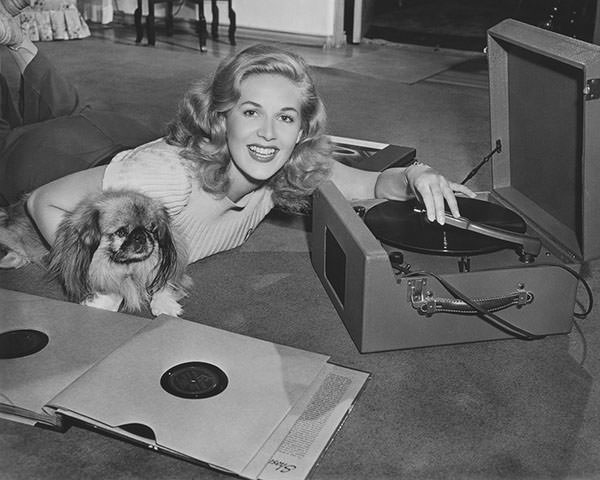
Records/Vinyl
Enter the LP, or “long play’ which exclusively refers to vinyl records and began in 1948 with 12-inch vinyl. It also had a 10 inch version and was characterized by a speed of 33 1/3 RPM. The vinyl record was the standard in the recorded music industry. Vinyl was the preferred medium for albums because it was more durable and had less surface noise than shellac. Shellac was also in short supply during World War 2 and so vinyl was substituted. It was also better because it was inexpensive and provided reliable playback. Post war America saw a boom in vinyl’s due to a skyrocketing economy and the barrage of musical artists entering a budding music scene. Albums could have vibrant, colorful covers and came in both 10 and 12 inch variations. Reel to Reel (see Magnetic Tape below) recorders were a direct challenge to LPs but due to their high maintenance and cost, never achieved the same widespread embrace as vinyl records. LPs were truly challenged in the 70s by cassette tapes.
EP records (Extended Play, from a single song to a couple songs long; i.e. not enough music for a whole album) were also popular; they directly competed with LPs. EPs had different sizing options available. The 7 inch varieties, the most common and popular, were called “7 inch” or “45s” referring to their tendency to play at 45 RPM. 12 inch singles were introduced in the 70s for disc jockeys in discos. Record players became more compact and less expensive making them an affordable item for the home.
The format war regarding record sizes is interesting because record companies expected that 12 inch varieties would appeal to classical music enthusiasts (who would want uninterrupted musical experiences) and 10 inch varieties would be better suited for pop genres (who have shorter tracks and more singles). Popular music was continuously released on 10 inch varieties but were found to not be preferred at all. 10 inch and 78RPM records were discontinued but briefly resurfaced as Mini LPs in the late 70s and early 80s.
Vinyl records, though they can last a very long time if properly cared for, are vulnerable to a multitude of conditions such as dust, heat, and physical damage. Physical damage can occur during play such as cue burn and from poor quality turntables, tonearms, and styli.
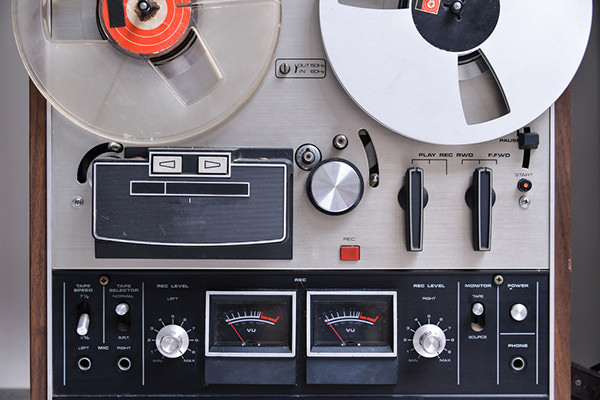
Magnetic Tape
Germany brought in the magnetic era of audio recording with magnetic tape in the 30s. The rest of the world didn’t have access to it until after World War 2 with the Allied victory. Magnetic recording was far superior to previous methods in that it was almost indistinct from live broadcasts. Tapes could also be transported easily. It allowed for greater freedom in editing and sound manipulation, which led to an explosion of musical styles, sophistication, and innovation in the industry.
Reel to reel audio originally referred to all tape recordings but a name was needed to differentiate it from other options that had different housings like cartridges and cassettes. Reel to reel originally used steel tape. In 1949, pre-recorded reel to reel tapes were released to the USA which did not have any popular artists and had less than 10 titles. It was the most popular from the mid-60s but other formats (with more portability and less cost) often won over consumers instead. It remained, however, a great favorite among audiophiles who would contend with the larger equipment and time consuming threading required. The gap between reel to reel and cassette tapes became indistinguishable in terms of audio quality. Some audiophiles preferred them over anything else. You can see one in Uma Thurman’s character’s home in Pulp Fiction.
The notorious 8-track tape was popular between 1964 to 1988. Its popularity is due to its presence in car audio systems. It was convenient and very portable. The demand spread from car audio systems to demand for home based systems. Consumers could listen in their car, remove the tape, and then continue to listen at home. The 8-track succeeded the Muntz Stereo-Pak (commonly known as the 4-track) tapes, which though they have the potential for higher audio fidelity, hold half as much music and were more susceptible to damage due to the lack of a pinch roller (this moves the tape). They also had to be switched manually, rewinding was impossible, and fast forwarding was risky. 8-track tapes officially overtook 4-track in late 1970 when they ceased to be made by its inventor, Earl Muntz.
The compact cassette was introduced in 1962, could hold up to 60 minutes of music, and was smaller and easier to handle than the 8-track. Once compact cassettes surpassed the quality of the 8-track, they very quickly replaced them. Its popularity was facilitated by Sony’s Walkman, which was released in 1979. For the first time, you could listen to your music without bothering others in public as you went on your morning jog, did chores, or commuted on the bus. Even more exciting was the ability to create a mixed tape using free broadcasted radio. People could copy broadcasted music onto blank tapes and create a personalized audio experience. Most would agree that the difficulty in ensuring a “clean” copy made it something of an art form. The “mixed tape” era bean.
Vinyl records and cassette tapes continued to uphold the personal audio market until the invention of a major game changer, the compact disc.
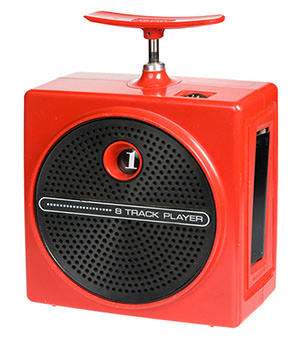
Optical Media
Developed by both Phillips and Sony in 1982, the compact disc (CD) evolved from LaserDisc technology that uses lasers to allow for the high data density necessary for superior digital audio signals. CDs were a big deal because they were the beginning of both the digital and recordable disc era. Earlier tech used captured analogue of sound; digital recording grabs audio through dense and fast sound samples which combined to form a continuous sound. This became the go-to method for recorded music, starting with Ry Cooder’s “Bop ‘Til You Drop” in 1979.
The recordable disc era was a long lasting market and user trend that endured as long as the CDs reign over the music industry. The introduction of rewritable CDs, (CD-R and CD-RW) in 1990, which could be written and re-written, allowed consumers to create mix audio discs (the mixed tapes of its day). These types of discs could be bought retail by either businesses or individual consumer. Songs could be ripped from legitimately purchased albums and copied to multiple writable discs at home. These songs could be distributed among family or friends but were also shared on digital sharing platforms like Limewire and Napster which sprung up in the late 90s and early 2000s.
Discs can record between 70-80 minutes of music depending on the disc type and CD recorder. They also have excellent audio quality and performance, more so than other digital formats. They have high fidelity, portability, durability, and elicit a complete sound spectrum with no distortion and perfect clarity. They are easy to burn and write; they don’t require much in the way of training to use and edit. Many musicians got their start by burning their music at home and then distributing locally or hiring a printing house to print batches. Though susceptible to scratching, discs offer printable space for additional space and content like lyrics and other exclusive content due to their size and packaging (the iconic jewel case).
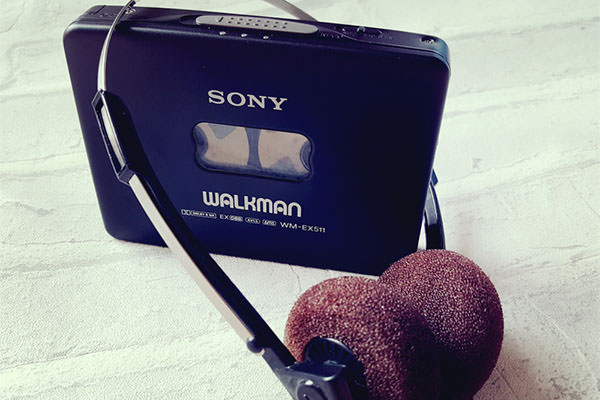
For roughly 30 years, the CD was the undisputed king of audio distribution and consumption. It spawned a number of industries and formed the backbone of data and media transfer, distribution, and consumption. It is responsible for putting data storage and manipulation readily into consumers hands on a massive scale previously unheard of. However, CDs began to fall off in the 2000s, especially after 2010, with the increasing popularity of the mp3 format used in digital music players (often called mp3 players). Discs have since become a niche product used and loved by those who still remember its value. You can learn more about who’s still using CDs from our previous blog.
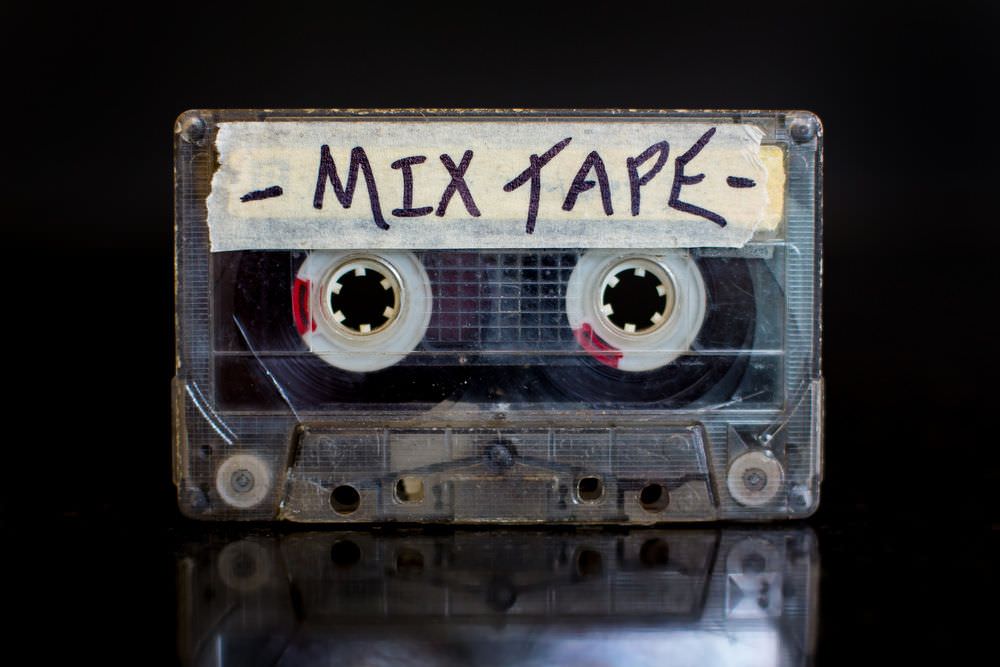
Digital
The mp3 format, created in 1993, didn’t take off until the late 90s with the popularity of Napster, a peer to peer file sharing website that allowed users to share audio files without purchasing them. This led to wide spread music piracy that troubled the music and movie industry, prompting several imitators like Pirate Bay and Limewire. Digital music is a versatile format, allowing easy manipulation, sharing, and downloading with very little storage space requirements or cost. Its easy distribution and sharing, plus the magnitude of data and users who were participating, made it difficult to control. Piracy was rampant. Record labels—lords, leaders, movement makers—were cohesively opposed to this new music outlet that allowed consumers to avoid paying steep disc prices and download specific songs and albums.
Napster had numerous critics, including musicians and record labels who were miffed at the lost royalties and copyright infringement. Napster was almost immediately sued by the Recording Industry Association of America (RIAA) in late 1999 and several artists (Metallica, et al. v. Napster, Inc) in 2000. Record companies were concerned that the obvious and inevitable leap to piracy would cut into their profits; they also felt that Napster contributed to copyright infringement and ignored copyrights. Musicians and bands were also concerned because of the potential loss of revenue from royalties and control over their work. Both Metallica and Madonna had music “released” to the public prematurely that spread across the internet and was even broadcast on radio.
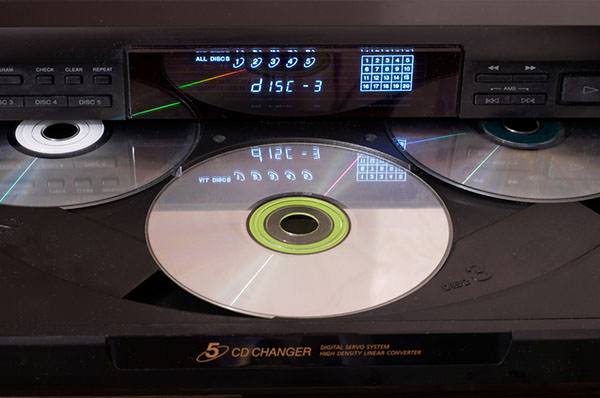
Napster lost the suit and the appeal. They failed to follow guidelines set up after the suit and therefore had to shut down service mid-2001, declare bankruptcy, and sell off its assets in 2002. This certainly didn’t stop people from “file sharing” as its shut down drove users to flock to other file sharing sites that popped up to fill its place.
Streaming
Record labels eventually became wise to the potential gold mine that Napster perhaps had unearthed. Instead of merely suing those companies, they bought into the idea and turned it into a legitimate business model. In 2003, Apple released iTunes for Windows operating systems. Initially announced in 2001, it was the only online digital media store at the time. It nicely timed with the iPod, an mp3 player also released in 2001 but not taking off until after a year after iTunes’ release in 2004. The iPod originally had 5GB of storage space for songs, but a 10GB version was released later. In comparison, 700MB is the typical storage space for a CD. Early iPod sales were slow due to their limited compatibility with only Mac computers; sales lifted when PCs were made compatible.
Though not exactly a digital streaming service—rather a precursor—it offered a place for customers to obtain music legally. It charged per song, album, show, or movie. At the time, it provided a direct opposition for services like Napster and Limewire which offered pirated media at no cost (except perhaps a giant computer virus, if you were unlucky or not careful). As of 2015, iTunes also has a streaming service, Apple Music, which also features live radio called Beats 1 that broadcasts globally.

True digital streaming services like Pandora and Spotify are now an increasing majority in music consumption, which is also now recorded digitally. For a small monthly subscription fee, you have access to thousands of albums and songs at a time—no charge per song or album. There are two types: interactive and non-interactive. Non interactive functions like satellite radio, broadcasting groups or genres of songs that you choose. Pandora or Sirius XM are examples of a non-interactive streaming service. Interactive streaming is more like Spotify where you have access to songs without a radio format. You can keep a sizeable cache of songs “offline” where you can access them without using mobile data.
The medium is not without its criticisms. The pros and cons are a whole complete article unto themselves, but to be brief they boil down to sustainability, availability, and market practice issues. It is not possible to make everything available for streaming due to space constraints; companies are only interested in content that’s going to be popular and streamed repeatedly. This leaves only the most popular and newest content as top priority. Even music streaming, which doesn’t have the same space constraints of video and movie services, demonstrates a marked preference for the most listened and searched content, shoving less popular and new/up in coming artists aside.
Royalties and compensation for artists is also notoriously low, leading many artists to forgo signing their name on Spotify’s contract, like Taylor Swift. The financial side of streaming is a mess, and many theorize that it is not a stable venture; streaming services are not raking it in like you’d expect. The subscription model seems to barely cover bills for companies like Spotify, which must provide constant access and usability for their platform to customers. But the benefits are hard to ignore. It’s extremely portable and flexible. You only need your phone. It’s customizable. It’s low cost; no more $20 CDs (for 70 minutes of music, one artist or genre) or $1.99 per song on iTunes.
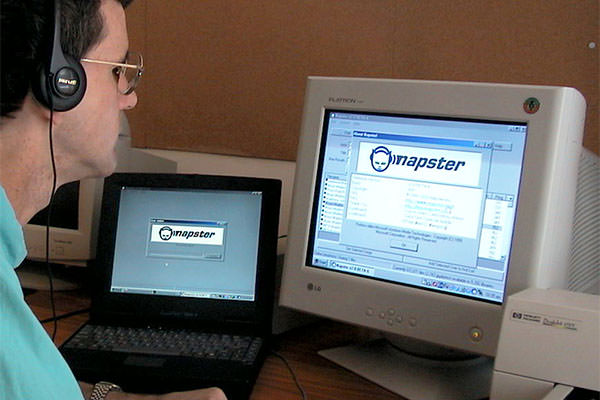
The Future of Recorded Music
Does this mean that physical media is at death’s door? It seems likely with CDs and vinyl records remaining a small market niche. The logical progression of recorded sound from purely physical components like metallic tape and vinyl plates to digital stored and deliverable mediums inevitably leaves discs and records in the dust of history.
But maybe not, at least for a while. While CD sales are not rising, they are surprisingly high despite their decade long degradation. Vinyl records are also rising in popularity again, likely due to nostalgia, the urge to return to a physical platform, and the love of the idea of quality. Vinyl records can last a long time if properly taken care of and they stand for a significant portion of recorded music’s history. Some believe the future holds a dual platform market comprising of digital streaming paired with a small, physical library for favorites. With digital streaming’s issues, it remains perhaps a necessity to retain some physical media. Not everyone has jumped on the streaming bandwagon, either.
Perhaps one day we will abandon the physical and completely rely on digital technology for our media and entertainment. Whatever form it may take, we shouldn’t forget what technological innovations and the musical revolutions they inspired came before. Hopefully, whatever comes next will be somehow even better than ever before
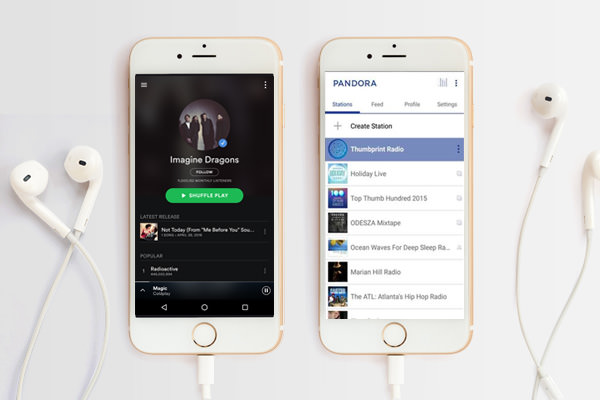
True digital streaming services like Pandora and Spotify are now an increasingly majority way to consume music, which is also recorded digitally. For a small monthly subscription fee, you will have access to thousands of albums and songs at a time—no charge per song or album.
There are two types of digital streaming: interactive and non-interactive. Non-interactive functions like a satellite radio, broadcasting groups or genres of songs that you choose. Pandora is a good example, or Sirius XM. Interactive streaming is more like Spotify where you have access to songs without radio format. You can keep a sizeable cache of songs in “offline” mode where you can access them without using your mobile data. There are quite a few streaming options on the market now and its popularity and use is only increasing.
This medium is not without its criticisms however. The pros and cons of digital streaming are a whole complete topic unto themselves, but to be brief they boil down to sustainability, availability, and market practice issues. It is not possible to make everything available for streaming due to space constraints; digital streaming companies are only interested in content that’s going to be streamed again and again, leaving only the most popular and newest content available. Even for music streaming, which doesn’t have the space issue of video and movie services, platforms show preference for the most listened to and searched songs which shoves less popular or new/up-in-coming artists aside. Royalties and compensation to artists is also notoriously low, leading many artists to forgo signing their name on Spotify’s contract like Taylor Swift. The whole financial side of digital streaming is a mess and many theorize it is not a stable venture; streaming services aren’t raking it in like you’d expect. The subscription model of payment seems to barely cover the bills for streaming services, which must provide constant access and usability for their platform to their customers.
Digital streaming has a lot of benefits that are difficult to ignore, and despite its issues it’s unlikely that we’ll go back to a more physical medium for our entertainment. It’s extremely portable and flexible. You only need your phone to access an entire library of possible music choices. It’s customizable to your own tastes so you’re not forced to sift through genres that don’t interest you. It’s low cost, too, which is much more attractive than shelling out $20 per CD that only comprises of one artist and only up to 70 minutes of music, or $1.99 per song on iTunes. Consumers want easy, low cost, and convenient access to whatever media strikes their fancy and digital streaming may be the answer to that desire.
So, does this mean that physical media is at death’s door? With the use of CDs falling and vinyl records remaining a small market niche, it seems likely. The logical progression of recorded sound from purely physical components like magnetic tape and vinyl plates to digitally storable and deliverable methods inevitably leaves discs and records in the dust of history.
But maybe not, at least for a while. While CD sales are not rising, they are surprisingly high despite their decade long degradation. Vinyl records are also rising in popularity again, likely due to nostalgia, the urge to return to a physical platform, and the love of the idea of quality. Vinyl records can last a long time if properly taken care of and they stand for a significant portion of recorded music’s history. Some believe the future holds a dual platform market comprising of digital streaming paired with a small, physical library for favorites. With digital streaming’s issues, it remains perhaps a necessity to retain some physical media. Not everyone has jumped on the streaming bandwagon, either.
Perhaps one day we will abandon the physical and completely rely on digital technology for our media and entertainment. Whatever form it may take, we shouldn’t forget what technological innovations and the musical revolutions they inspired came before. Hopefully, whatever comes next will be somehow even better than ever before.

